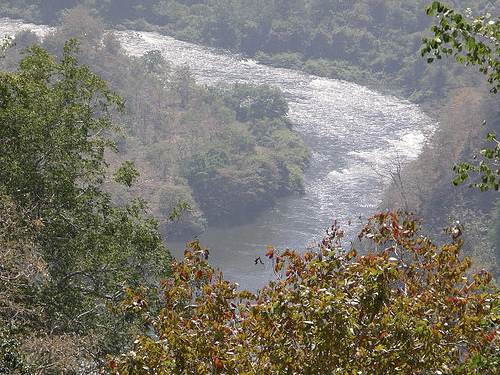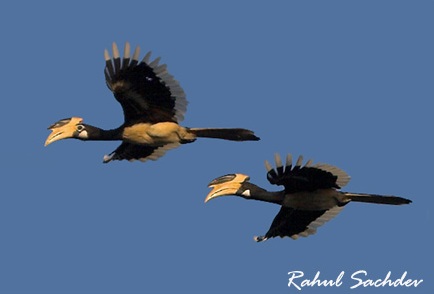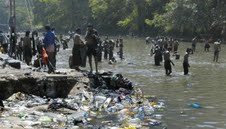Guest post by: Parineeta Dandekar
A landmark decision taken for conserving biodiversity-rich rivers and basins is the declaration of three conservation reserves in Uttar Kannada district of Karnataka, namely the Aghanashini Lion Tailed Macaque Conservation Reserve spanning 299. 5 sq. km, Bedthi Conservation Reserve, spanning 57.3 sq Km and Hornbill Conservation Reserve over 52.5 sq km, on 31st May 2011 by the State Government's Forest, Ecology & Environment Department.

Kali Nadi in Karnataka
Source: Divya
Background
In the Western Ghats, rivers arising from the mighty mountains and flowing towards the east are worshipped as Dakshin Vahini or Purva Vahini Ganga. And understandably so. While rivers which flow west of the water divide flow for mere 80-100 km before meeting the Bay of Bengal, rivers like Krishna and Godavari that fall to the south-east flow for thousands of kilometers, meeting tributaries, gathering strength and gifting life and livelihoods to hundreds of towns and villages in the downstream, before meeting the Bay of Bengal.
However it seems the short, swift and neglected west flowing rivers have a secret to keep. These river basins are the protectors of some of the richest biodiversity pockets in India, while providing a range ecosystem goods & services to the mountain & coastal populations.
These rivers cut across the Western Ghats and coastal strip of Gujarat, Maharashtra, Goa, Karnataka, Tamilnadu and Kerala. The region is traversed by as many as 115 small and some fairly big rivers. According to National Institute of Hydrology (NIH), of these 115 rivers, one in Tamil Nadu, 32 in Kerala, 10 in Karnataka, 3 in Goa, 11 in Maharashtra and 5 in Gujarat are important rivers with more than 23 large dams built on them for water supply and hydropower [1].
Some of these rivers have been spared as yet from large dams, because of their ‘difficult’ location. However, most of these unique rivers are being degraded rapidly and irreversibly through large dams, diversions, power plants and polluting industries on their banks.
For example, the Vashishthi river in Maharashtra suffers doubly as its natural hydrograph is skewed beyond control by water releases of the Koyana hydro electric project, which diverts water from water deficit Krishna valley to water surplus Konkan region for electricity generation. At the same time, Vashishthi houses one of the most polluting stretches of chemical industries on its banks at Lote Parshuram village. Lote Parshuram MIDC has severely polluted the river, making its water unfit for consumption and releasing toxic wastes without treatment, resulting in near total destruction of fisheries and dependent livelihoods in the Vashishthi estuary downstream. Same is the case of Patalganga River, which arises from Matheran and flows down to form the Dharamtar creek.

Dams on Bedthi, Aghanashini and Kali rivers
Rasayani chemical industrial belt along Patalganga has rendered its water entirely unfit for consumption, killing fish and rendering agricultural lands fallow and poisoned [2].

Fish Kill in River Kundalika, Roha, Maharashtra
Source: Afternoon Dispatch
West flowing rivers in Goa, lifelines of the tiny state, face a terrible fate due to rampant illegal mining in river beds and banks. In the catchment of Mandovi, 27 mines generate more than 10000 tonnes of mining rejects per year, which end up in the river. River Zuari faces the same problem, while River Khandepar has 21 mines within one square kilometre (For details on impact of mining on rivers in Goa: April May 2011 issue of “Dams, Rivers & People”, page 10-12; you can also read this on IWP by clicking here).
Story of river Kali in Karnataka is no different. Kali, a 184 km long river, flowing through Uttara Kannada district of Karnataka is one of the ‘hottest hotspots’ of Western Ghats, showing remarkably high biodiversity, species endemism and unique ecosystem goods and services. The river has six dams, world’s only nuclear power station in a forest, the Kaiga Power plant, and polluting paper industries on its banks. The Centre for Ecological Sciences (CES), Indian Institute of Science has studied the Ecological status of Kali floodplain.
According to CES, ‘Six major dams across the river, a nuclear power plant and the paper and sugar industries on its bank have already caused tremendous loss of the biodiversity in the region. Any further development be it a hydro electricity project or any thermal power plant in the district is likely to cause a lot of damage the left over biodiversity as well as it will harm the fish production capacity of the region’ [3]. Campaigns by Environment Support Group, Bangalore and others in the past have been able to stop the proposed Dandeli hydropower project and some other destructive proposals.
Pollution of river Kali has been affecting fisheries, agriculture and cattle of the area. The effluent discharges have resulted in epidemics and deaths due to Gastroenteritis in the villages downstream. Time and again, the Karnataka State Pollution Control Board has been turning a deaf ear towards complains filed by local communities [4]. This is very similar to the response of Maharashtra Pollution Control Board regarding pollution of Vashishthi due to chemical industries in Lote Parshuram village. According to the Western Ghats Expert Ecology Panel Report, the only response of the MPCB has been to shift the field office from Lote MIDC to Chiplun, ‘rendering any chances of effective action even more remote than before.’ Similar is the situation in west flowing rivers of Damanganga and Kolak in Gujarat, which receive toxic effluents from more than 1000 individual factories in Vapi. This town had been considered as one of the top ten most polluted places in the world [5].
Though the terrain and strata do not encourage large dams, most of the west flowing rivers have been dammed many times over. All of Mumbai’s water supply for domestic and industrial purposes comes from dams built on west flowing rivers in forest region. Mumbai is now planning to build more than 8 dams on some of the last free flowing rivers of the region like Kalu, Shai, Pinjal and Gargai. At the same time, the Damanganga-Pinjal Link, a part of the controversial National River Interlinking project foresees not only a dam across Pinjal River in Thane district of Maharashtra, but a link between Damanganga Dam from Gujarat to Thane, through Western Ghat Forests.
In Karnataka too, west flowing rivers like Kali, Sharavathy, Nethravathy and Varahi have been dammed and diverted at several places, degrading riverine biodiversity, local water supply and fisheries of these basins. Interlinking of Rivers proposals involve further links involving Hemavathy, Nethravathy, Bedthi and Varda rivers.

Hornbills at Kalinadi, Dandeli.
Source: Rahul Sachdev
For Kerala, west flowing rivers form its lifelines and nearly all of the major rivers have been dammed and diverted, including the Chalakudy, Nayar, Sholayar, Kuttiyadi, Bharathpuza, Pamba and Periyar.

Pilgrims taking bath in the polluted Pampa River Source: The Hindu
In this scenario, there is an urgent need to protect these ecological and social wonders from being further degraded. It has been seen that the laws like the Wildlife Protection Act (1972), the Water (Prevention and Control of Pollution) Act (1974), the Forest (Conservation) Act (1980), the Environment (Protection) Act (1986), Biological Diversity Act , 2002, etc., despite holding many applicable sections, have proved to be ineffective because of absence of enforcement & community participation. A number of organisations and communities have been demanding that these areas and rivers should be declared as eco sensitive and should be protected from further disturbances [6].

Aghanashini river
Source: with thanks from Asif Mailk
A landmark decision in this regard is the declaration of three conservation reserves in Uttar Kannada district of Karnataka, namely the Aghanashini Lion Tailed Macaque Conservation Reserve spanning 299.5 sq. km; Bedthi Conservation Reserve, spanning 57.3 sq. km and Hornbill Conservation Reserve 52.5 sq. km, on the 31st May 2011 by Karnataka Government's Forest, Ecology & Environment Dept.

Conservation reserves
Conservation reserves are a new concept in the rigid framework of protected areas under the Wildlife (Protection) Amendment Act of 2002. The novel part of these reserves is that they seek to protect habitats that are under private ownership also, through active stakeholder participation. They are typically buffer zones or connectors and migration corridors between established national parks, wildlife sanctuaries and reserved protected forests in India. They are designated as conservation reserves if they are uninhabited and completely owned by the government but used for subsistence by communities, and community reserves if part of the lands are privately owned. Administration of such reserves would be through joint participation of forest officials and local bodies like gram sabhas and gram panchayats. They do not involve any displacement and protect user rights of communities.
The setting up of these conservation reserves was a part of a lengthy process which involved a number of staekholders. For example, in case of Aghanashini Lion Tailed Macaque (LTM) reserve, a detailed survey was carried out by Karnataka Forest Department, SACON and ATREE which confirmed largest LTM population in this region. This formed the basis to identify the area as a potential conservation reserve for the lion-tailed macaque. A plan was submitted to Principal Chief Conservator of Forests (Wildlife) in 2008 and also presented to Western Ghats Task Force Committee. It was considered as one of the priority issues by the Western Ghats Task Force Committee during the meeting in 2008-09. Scientists from SACON carried out studies with the help of Karnataka Forest Department and CEPF-ATREE Small Grants in this region while pursuing with officials to form a lion-tailed macaque Conservation Reserve for the region adding little more sensitive forests along Aghanashini River and other important fauna and flora of the region to strengthen the fact. In this regard boundary was remarked with the technical support by Mr. Balachandra Hegde and a new proposal was prepared. Deputy Conservator of Forests submitted the proposal to the State Govt and efforts were made to pursue the matter with State Wildlife Advisory Board [7].

Lion Tailed Macaque in the Aghanashini basin
Source: Deccan Herald
Driving force behind the idea
Balachandra Hegde, born and brought up in a remote village in the Aghanashini valley and recipient of the Ruffords Grant Award for conservation has been one of the strong proponents of the idea. Here is the story in his words:
‘Uttara Kanada district from central western Ghats, Karnataka has four major rivers flowing through it: Kali, Bedthi, Aghanashini and Sharavathi. Out of these, river dynamics of Kali and Sharavathi are already disturbed by 6 and 3 dams respectively. However, like the situation world over, free flowing rivers support immense biodiversity and livelihoods in this region. In Aghanashini alone, bivalve-based economy has an estimated turnover of Rs 57.8 m per year. It generates direct employment for about 2,347 people, and nutritional security of many more along the Karnataka coast and also in neighboring states'[8].
Long history of development v/s environment
Uttara Kannada district has about 81 % of its geographical area under forest administration. Though actual forest cover of the district is much less, reliable estimates say at least 60 % of the region is under forests. 1.4 m people live in the district, which has 10251 sq km of geographical area. Only 11 % of the area is cultivated. Population density is about 140/sq kms (Census of India, 2011).
Uttara Kannada has a long history of being proactive about environmental concerns. Bedthi and Aghanashini are freely flowing till today only because of the strong people’s movement in the region since last three decades. Several development projects like hydro electric dam, mini hydel projects, thermal power projects, were proposed along these rivers. Thanks to generations of local people and peoples movements for protecting the river valleys from such development projects.
Karnataka Government had decided to build major dams across these two rivers during 80’s. Widespread opposition to these plans created national level discussion about the projects. Around 2004, Central Electricity Authority planned hydro electricity dams across these rivers under its ambitious project called ‘50,000 MW hydro electric initiatives’. Conservationists and activists of Uttara Kannada got together to find long lasting ways to stop such efforts. A meeting was organized at Svarnavalli, Sonda, near Sirsi, during 2006 to identify the conservation strategies.

Dr. Balachandra Hegde at Aghanashini river
Dr Hedge suggested identifying biodiversity hotspots rich with high conservation value within the landscape and proposed protecting these hot spots with legal options like conservation reserves. A detailed survey was conducted for this purpose with the support from Western Ghats Task Force and Karnataka Forest Department. Presence of endangered and endemic species, critical corridors connecting larger Western Ghats landscape and potential threats for the region etc., were considered for identifying conservation priority areas.
10 priority conservation areas were identified within this landscape and three conservation reserves covering these priority areas were proposed. Primarily, areas along Bedthi, Aghanashini and Kali river valleys received conservation Reserve tag. The three reserves set out to protect Lion Tailed Macaque Habitats, rare and endangered Myristica Swamps of the Western Ghats and Hornbill habitats. While the focus is conserving each of these iconic species, the end result of protecting the entire ecosystem will lead to conservation of a number of other endemic and endangered species including the free flowing rivers!
We hope that these conservation reserves herald a beginning of innovative ways devised by communities and experts to protect our last remaining, rare and extremely valuable free flowing rivers. Many such rivers all across the country have been nurturing biodiversity and supporting livelihoods and it is high time that civil society groups, scientists and policy makers come together and look for various ways to protect these rivers from the onslaught of dams and pollution, for the current and future generations.
References
1. West flowing rivers south of Tapi - National Institute of Hydrology
2. Will area water partnerships give people back their rivers? - Infochange
3. Ecological status of Kali river flood plain - Centre for Ecological Sciences
4. Kali bachao andolan - Environment Support Group
5. World's worst polluted places, Vapi, India - Blacksmith Institute
6. Ecological status of Kali river flood plain - ENVIS technical report
7. Honnavalli N. Kumara, Declaration of “Aghanashini Lion-tailed Macaque Conservation Reserve”, Salim Ali Centre for Ornithology and Natural History
/articles/saving-some-last-remaining-free-flowing-rivers